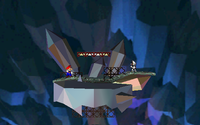Meta Crystal
The title of this article is official, but it comes from a Japanese source.
If an acceptable English name is found, then the article should be moved to the new title.
Meta Crystal is a cavern-like stage in Super Smash Bros. It consists of a red wire platform hovering above a larger, uneven crystalline structure. It is not unlockable, and it only appears for the battle against Metal Mario in 1P Game. The background is made up of metallic crystals and a red wire fence, likely intended as a reference to similar objects found in the Hazy Maze Cave and the Cavern of the Metal Cap in Super Mario 64.
This stage is the only one in the entire series not to be remade in another form or replaced in later installments. All others are either updated (i.e. Battlefield and Final Destination) or replaced with similar counterparts (series-based stages), as metal characters in future single-player modes are fought on Battlefield in Super Smash Bros. Melee and on a randomly chosen stage in Super Smash Bros. Brawl.
Names in other languages[edit]
| Language | Name | Meaning | Notes |
|---|---|---|---|
| Japanese | メタ・クリスタル[1] Meta Kurisutaru |
Meta Crystal |
References[edit]
| Super Smash Bros. | ||||
|---|---|---|---|---|
| Playable characters | Donkey Kong • Fox • Kirby • Link • Luigi • Mario • Samus • Yoshi • Others | |||
| Non-playable characters | Bob-omb • Whispy Woods | |||
| Bosses | Giant Donkey Kong • Metal Mario | |||
| Stages | Peach's Castle • Yoshi's Island • Congo Jungle • Hyrule Castle • Meta Crystal • Mushroom Kingdom • Others | |||
| Items | Barrel • Bob-omb • Bumper • Crate • Egg • Fire Flower • Green Shell • Hammer • Red Shell • Star • Star Rod • Target | |||
| Moves | Miscellaneous | Jump • Taunt | ||
| Special | Standard | Up | Down | |
| Mario | Fireball | Super Jump Punch | Mario Tornado | |
| Luigi | Green Fireball | Luigi Cyclone | ||
| Donkey Kong | Giant Punch | Spinning Kong | Hand Slap | |
| Yoshi | Egg Lay | Egg Throw | Yoshi Bomb | |
| Other | 1999 Nintendo Power Awards • Ask Dan • Ask Uncle Tusk • Emblem • Gallery • Glitches • Miyamoto on Zelda • Pre-release and unused content • Quotes • Rösta på ditt favoritspel och vinn en N64! • Smash Card • Super Smash Bros. Poll • Super Smash Bros. (Shockwave game) • Staff | |||
